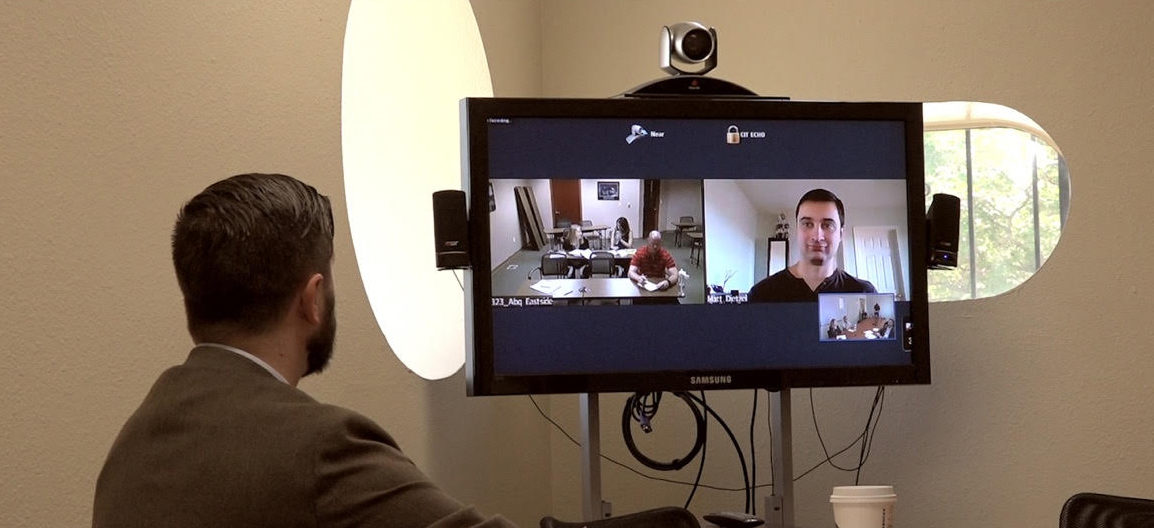The Therapist is a Cop
Dan Duhigg, an assistant professor of psychiatry at the University of New Mexico School of Medicine, sits at an oval table in a small conference room with Raymond Maynes, a crisis specialist with the Albuquerque Police Department. Opposite them is a large monitor, its screen split into a half-dozen squares, where the faces of six police officers from departments around the state — many in rural areas where mental health intervention training is not readily available — stare back.
“So let me summarize the case,” Duhigg says. “We’ve got a 51-year-old man in Las Cruces, New Mexico, who enlisted a cab driver to buy an AR-14 assault rifle — gave him $10,000 cash. The gun shop alerted you. Meanwhile, the same guy walked into an RV dealer, found a model he liked, and left a bag filled with $40,000 as a deposit. The RV folks called you, too. According to the cabbie, the man was going to drive the RV to White Sands National Monument, fight the ISIS contingent there — and then travel to one of Hillary Clinton’s campaign stops and kill her. Is that about right?”
“That’s pretty much it,” says Officer T.J. Camacho, from the Las Cruces Police Department, leaning back in his desk chair. “He sounds like he’s bipolar, but we can’t hold him on that, so we’ve got him under constant surveillance, and the FBI knows about him.”
Duhigg tells Camacho that he, too, suspects Las Cruces is dealing with a bipolar personality. “It’s springtime,” Duhigg says, “and that’s when we see a lot of manic behavior.”
The unusual exchange grows out of a new partnership between the Albuquerque Police Department and the University of New Mexico School of Medicine’s Project ECHO — a 13-year-old initiative that began as an effort to help inform primary care doctors in far-flung areas of the state in the treatment of hepatitis C, but has now expanded to become a knowledge-sharing network across a variety of diseases and specialties. Today, the videoconferencing network is used by medical practitioners worldwide — a virtual consultative clinic, where specialists at a medical center help community clinicians manage patients with a range of chronic diseases.

In this case, however, the practitioners aren’t physicians, they’re police officers, and they are learning how to better manage the people they see every day — many of who present with mental illness.
It’s an experiment that could help address a nationwide problem. Across the country, mental health systems are fragmented and failing, and police departments have become front-line mental health workers by default. Far too often, for both the mentally ill and their distressed families, police are also the responders of last resort, sometimes with disastrous consequences.
The problem manifests in jurisdictions from New York City, where police fatally shot a 66-year-old schizophrenic woman last week, to suburban San Diego, where a man wielding an electronic cigarette — and described by his family as mentally ill — was shot dead by police last month. The Washington Post, which has been tracking police shootings, has tallied 184 police killings of people with diagnosed mental illness so far this year.
After numerous incidents involving the Albuquerque Police Department — including the infamous and grisly 2014 police killing in of a schizophrenic homeless man named James Boyd, which was captured on video — the U.S. Department of Justice stepped in. A settlement agreement required, among numerous other reforms, that the police department create an advisory committee to review training, policies, and procedures for dealing with the mentally ill.
The case against two former police officers facing second-degree murder charges in Boyd’s death ended in a mistrial earlier this month.
I’m a professor of family and community medicine at the University of New Mexico, and a volunteer attending physician in ECHO’s chronic pain and headache clinic, where I worked with Dr. Duhigg. When I learned about the ECHO program’s fledgling connection to the Albuquerque Police Department, I thought it seemed an ideal use of the ECHO model, and I had to learn more.
“I think I’m the only full-time psychiatrist in the country working for a police department,” Nils Rosenbaum told me as a roomful of recent Albuquerque Police Academy graduates were preparing to begin a 40-hour course in crisis intervention. Both Rosenbaum and Duhigg — colleagues at the university — now sit on the police department’s mental health response advisory panel.
Rosenbaum explained that he and Detective Matt Tinney had seen an ECHO presentation that Duhigg gave last year and wondered, if it worked so well teaching doctors, “why not try it with cops?”
Project ECHO and the Albuquerque Police Department’s Crisis Intervention Team started this weekly videoconference early this year, and it is proving particularly helpful for rural and small town police departments.
Rio Arriba County, in rural northern New Mexico, for example, usually leads the state in both health disparity and crime statistics. During my visit, Captain Randy Sanchez of the Rio Arriba County Sheriff’s office, a regular participant in the weekly CIT/ECHO conferences, presented a case of a man with severe mental health problems in need of mandatory treatment — and a judge unwilling to sign an order without more evidence. The online advice, from a number of police departments: Use body cameras to record police interactions with him.
“That’s what we’re going to do,” Sanchez said. “I’m a big supporter of the networking available through the CIT/ECHO. The ability to establish contact outside of our usual circles is a great advantage.”
Later, Sergeant Scott Facka, with the San Juan County Sheriff’s office in northwestern New Mexico, described the case of a man who was making constant calls to the power companies in this oil- and gas-producing region, telling them he was Yahweh and threatening them.
A helmet camera video captured the fatal shooting of James Boyd, a schizophrenic homeless man, by Albuquerque police in 2014. (Graphic video)
“When I tried to talk to him, he told me he was dead, and the medical examiner was taking things out of his pockets,” Facka said. “We had no idea of how to deal with him. He’d talk nonstop about it. He was out of control.”
Duhigg suggested the man might have Cotard’s syndrome, or “walking corpse syndrome,” a rare delusion in which the person believes he’s dead or doesn’t exist. “Dr. Duhigg suggested some ways of talking to him, to bring him back to reality — that he wasn’t dead,” Farka said, “and I was able to calm him down.”
At a subsequent ECHO session, Officer Camacho, from Las Cruces, called in from his parked cruiser and shared follow-up information about the man who threatened to kill Hillary Clinton. He’d been able to persuade the man to go voluntarily to a psychiatric hospital —though he left against medical advice after just six days, and they’d lost contact.
Detective Tinney then raised a new question for the group.
A rookie cop had asked for advice about his response to a young man with a history of mental illness whom he’d transported to the county mental health center. From previous encounters, the officer knew that the man, standing in his front yard, was Greg, but when he asked him his name, he responded, “Adam.” The officer went along with him, thinking he might be delusional, although during the transport, he didn’t notice anything else unusual. The question was, should one challenge a possible delusion, or play along with it?
Tinney asked if there were any suggestions from the network, and several officers voiced support for the rookie’s approach.
Then Duhigg chimed in.
“I believe in gravity,” he said, leaning back in his chair, his hands laced behind his head. “If someone came in this room and told me that gravity didn’t exist, I might think he was crazy. Folks who think they’re Adam, the first man, or Jesus, are just as convinced [of that reality] as I am that gravity exists. No use arguing until treatment begins to make a difference.”
The six cops, looking on from the digital array, nodded in agreement.
Benson Daitz, M.D., is a professor at the University of New Mexico School of Medicine, a documentary filmmaker, and a novelist. He has written for The New York Times, The Atlantic, and Eclectica.










